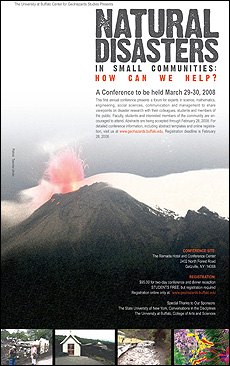Archives
Helping small communities in a disaster
By ELLEN GOLDBAUM
Contributing editor
Whether it’s springtime flooding, an infectious disease outbreak or a volcanic eruption, small or rural communities affected by natural disasters often suffer additional hardship because of their size, say organizers of “Natural Disasters in Small Communities: How Can We Help?” a conference sponsored by the University at Buffalo on March 29 and 30.

The conference, which will be held at the Ramada Hotel and Conference Center, 2401 North Forest Road, Getzville, is open to faculty, students, researchers and all stakeholders in the consequences of natural hazards. For more information, go to the Geohazards Web site.
“In the U.S. and around the world, smaller communities, clusters of less than 20,000-30,000 people, are generally less well-prepared to deal with extreme natural phenomena than are larger communities,” said Michael F. Sheridan, director of the UB Center for Geohazards Studies, which is organizing the conference. “They often are caught by surprise by an event that probably has been brewing for a long time.
“Small communities generally lack the more sophisticated communication networks, hospital facilities, crisis rescue squads, emergency housing and other resources that larger communities have,” he added. “They also are more remote, which means help takes longer to arrive.”
To address the disaster and emergency management issues specific to small communities, the multidisciplinary conference will feature presentations and case studies by researchers from across the U.S. and the globe focused on a broad range of hazards.
Among the disasters researchers will discuss are: volcanic activity in Chile and Argentina; a 2005 dengue fever outbreak on the border between Texas and Mexico and evacuation questions in communities near Ecuador’s Tungurahua volcano.
A cross-disciplinary group of geographers, geologists, computer scientists, engineers, mathematicians and social scientists will present data on planning, communication, modeling and assessment tools, such as remote sensing, satellites, geographic information systems and high-end computation.
Several presentations will focus on disaster communication and management issues in small communities and will address the role of relief agencies and how social networks can help a community recover.
A key focus of the conference will be on a community’s resilience in the aftermath of disaster, Sheridan said.
“Resilience is the capacity to recover after experiencing a large disaster,” Sheridan explained. “Small, precautionary measures, such as construction of a barrier to divert mudflows, a plan to move to higher ground or the use of gas generators for prolonged power outages, can make a great difference in survival rates and overall resilience,” he noted.
The conference is an outcome of UB's strategic strength in mitigation and response to extreme events. Research in this area has been identified in the UB 2020 strategic plan as one of eight areas of strategic strength that, along with a commitment to academic excellence, will be the foundation elevating UB to the ranks of the nation’s top public research universities.
In addition to Sheridan, UB faculty participating in the conference include Marcus Bursik, professor; Eliza Calder, assistant professor; Beata M. Csatho, assistant professor, all in the Department of Geology; Hugh S. Cole, professor of urban and regional planning; Bruce Pitman, associate dean for research, College of Arts and Sciences and professor of mathematics; Christian S. Renschler, associate professor of geography; and Natalie C. Simpson, associate professor of management science and systems in the School of Management.
Bruce McCombe, dean of the UB College of Arts and Sciences, will make welcoming remarks.
Conference sponsors include the UB Department of Geology, the College of Arts and Sciences and the State University of New York, Conversations in the Disciplines.
Established in 2007, the Center for Geohazards Studies seeks to reduce harmful societal effects of such natural phenomena as volcanic eruptions, landslides, mudflows, avalanches, climate change and groundwater contamination. The center’s team of scientists and engineers work together with social scientists, urban planners and public-health researchers to evaluate harmful effects of hazardous geological phenomena. The goal is to integrate analyses of the various impacts of geophysical mass flows from natural disasters on lifelines, structures and the environment in order to reduce property losses, bodily injury and mortality.
